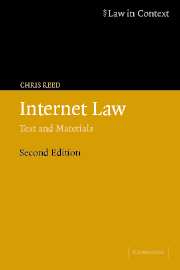Book contents
- Frontmatter
- Contents
- Preface
- Table of UK Statues
- Table of statutes–foreign jurisdictions
- Table of European Communities legislation
- Table of Conventions and Agreements
- Table of cases
- Introduction
- 1 The Internet as a distributed environment
- 2 From each according to his ability : actors and activities in the Internet world
- 3 An infinity of scarce resources : ownership and use of Internet resources
- 4 New actors on a new stage : intermediary liability in the Internet world
- 5 On the Internet, nobody knows you're a dog: identity and identification
- 6 Old wine in new bottles : traditional transactions in the Internet environment
- 7 The long arm of the law : cross-border law and jurisdiction
- 8 Legislative and regulatory arbitrage
- 9 Enforceability in the Internet environment
- 10 Facing the legislative and regulatory challenge
- Index
4 - New actors on a new stage : intermediary liability in the Internet world
Published online by Cambridge University Press: 05 June 2012
- Frontmatter
- Contents
- Preface
- Table of UK Statues
- Table of statutes–foreign jurisdictions
- Table of European Communities legislation
- Table of Conventions and Agreements
- Table of cases
- Introduction
- 1 The Internet as a distributed environment
- 2 From each according to his ability : actors and activities in the Internet world
- 3 An infinity of scarce resources : ownership and use of Internet resources
- 4 New actors on a new stage : intermediary liability in the Internet world
- 5 On the Internet, nobody knows you're a dog: identity and identification
- 6 Old wine in new bottles : traditional transactions in the Internet environment
- 7 The long arm of the law : cross-border law and jurisdiction
- 8 Legislative and regulatory arbitrage
- 9 Enforceability in the Internet environment
- 10 Facing the legislative and regulatory challenge
- Index
Summary
As we have seen in Chapters 1 and 2, the internet technologies require the participation of intermediaries to make transactions possible. Although intermediaries such as banks or commercial agents play an important part in physical world commerce, there are fundamental differences between physical world and internet intermediaries:
Physical world intermediaries are conscious actors in the transaction, whereas internet intermediaries are often unconscious actors.
Physical world intermediaries have a prior, legal relationship with one of the primary actors; internet intermediaries more commonly have no pre-existing relationship.
In essence, internet intermediaries play one of two roles in an information transaction. They may provide services to one or more of the parties, including fundamental communications services such as access, information storage, etc. Alternatively, they may provide some additional service which facilitates a transaction between end users, eg identifying one of the parties, providing search facilities, etc. Liability for providing defective services of this kind will be based on established legal principles, although the application of those principles to previously unknown types of service may not be obvious.
More important, though, is the role of intermediaries in relaying information through TCP/IP packet switching. This raises the question of their potential liability for the third party information content of those packets. Although these intermediaries operate via software which processes information automatically and in ignorance of its content or the nature of the transaction, in some cases they are the most easily identified targets for legal action if information content which they carry infringes a third party's rights.
- Type
- Chapter
- Information
- Internet LawText and Materials, pp. 89 - 139Publisher: Cambridge University PressPrint publication year: 2004



